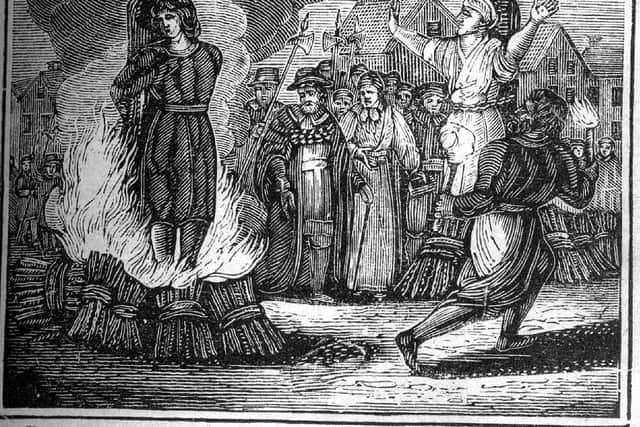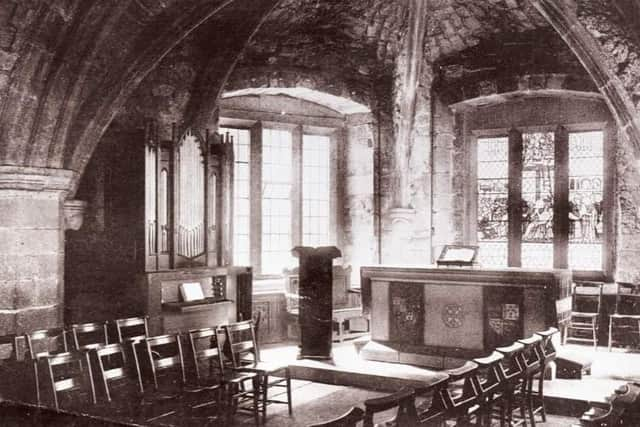The chilling shopping list of a Scottish city as it prepared to burn its 'witches'
The chilling document dates back to 1597 and comes from the Dean of Guild Accounts for the Burgh of Aberdeen. Written in Old Scots, it illuminates the realities of an unprecedented outbreak of witchcraft paranoia in the city and the terrible fate of those accused of such crimes.
One entry relates to the execution of Isobel Strathanchyn, also known as “Skuddie”, with the city procuring 26 “loads of peats for burning them” for 2lib (pounds) 13s and 4d.
Advertisement
Hide AdAdvertisement
Hide AdSix loads of firewood were also bought, as well as four barrels of tar at 6s 8d. A stake was bought for 13s and 4d, the price including its transportation and set up cost. Six fathoms of rope were purchased.


Meanwhile, Jon Justice’s fee of 13s and 6d was paid.
Phil Astley , City Archivist at Aberdeen City Council and Aberdeen City & Aberdeenshire Archives, said: “It is just there in black and white what was required.
“One of the most chilling things about these documents is that the executioner is referred to as Jon Justice. Obviously, this is not his real name but the mechanics of execution, the reality of it, is there to read in black and white.”


From separate court “dittays” held by the archive, it is known Isobel faced two charges in February of that year. She was accused of bending a penny, wrapping it in a hankie and then “enchanting the cloth” with a form of love spell which would bring the wearer together with the man she loved. The wearer later threw the cloth in a fire, which almost destroyed her house.
Isobel was also charged with gathering up “dead folk’s bones” from a churchyard at Dyce and boiling them in water, which was then used to treat a man as he lay on his death bed. The bones were then cast into the River Don, after which “the water rumbled in such a manner as [if] all the hills had fallen therein.”
At the height of the Aberdeen witch hunts of 1596 and 1597, around 40 cases were recorded locally, with many of the individuals being executed following significant periods of incarceration and torture. The vast majority were female.


The situation in Aberdeen was being replicated across the country following the introduction of the Queens Act of 1563, which stated that no person should ‘use any manner of witchcraft, sorcery or necromancy, nor give themselves forth to have any such craft or knowledge thereof’ with the crimes now punishable by death.
According to the archives, there was enthusiasm in the North East for identifying and persecuting witches during the 1590s as James VI pursued his own campaign against witchcraft and the un-Godly threats to his throne and dynasty.
Advertisement
Hide AdAdvertisement
Hide AdMr Astley said: “The King at the time was instrumental in creating the atmosphere and what was happening in the city was a way of it demonstrating its loyalty to the Crown, in a bizarre kind of way.”
Mr Astley said Aberdeen at the time was making international connections but remained “quite a religious and superstitious” place with the authorities “flexing their muscles” in the decades after the Reformation.


He said: "The witch hunts were an excuse, in a way, to prosecute people who didn’t fit into society and it is also a reflection of the suspicion about the latent sexuality of women
“It was obviously a very patriarchal society at that time and it was a way of the patriarchy extending its influence on the wider population. It was possibly a way of keeping certain section of society in fear. In the main, those who were accused of being witches were from the lower sections of society.”
The Survey of Scottish Witchcraft at the University of Edinburgh has identified over 3,800 cases of those accused of witchcraft between 1563 and 1736. Cases peaked between 1590 and 1662, when five large-scale witch hunts took place.
Today, there is growing momentum for calls to pardon those accused of witchcraft, led by the Witches of Scotland campaign. A private member’s bill to clear the names of those accused is to be brought to the Scottish Parliament this year.
In Aberdeen, those accused of witchcraft were held at St Nicholas Kirk – known as the Mither Kirk - in both the steeple and St Mary’s Chapel. It is said that suspects, including witches, were chained to a metal ring still embedded in the chapel wall
The kirk will become the setting of a new play on Scotland’s witch hunts which will be staged during Aberdeen’s Granite Noir crime writing festival later this month.
Advertisement
Hide AdAdvertisement
Hide AdWitch Hunt includes extracts from The Last Witch by playwright Rona Munro and tells of Janet Horne, of Dornoch, the last witch to be tried and executed in Britain. She was killed in 1727 after she was arrested, along with her daughter, amid claims she turned her daughter into a pony to transport her around the countryside.
Cameron Mowat, director and producer of Witch Hunt, said the Mither Kirk was the perfect venue for the production given it links to the the witch hunts.
He said: “I was on a tour of the building and saw the iron ring stuck in the wall. It is a tiny piece of evidence of our dark past. We will put on the play in the body of the kirk. We don’t want to make a political or spiritual statement, but we feel it is important to tell these personal stories rooted in a very dark time.”
Witch Hunt will be performed at St Nicholas Kirk, Aberdeen, during the Granite Noir crime writing festival from February 25 to 27.
A message from the Editor:Thank you for reading this article. We're more reliant on your support than ever as the shift in consumer habits brought about by Coronavirus impacts our advertisers.
If you haven't already, please consider supporting our trusted, fact-checked journalism by taking out a digital subscription.
Comments
Want to join the conversation? Please or to comment on this article.